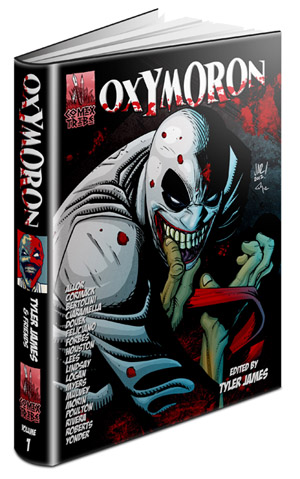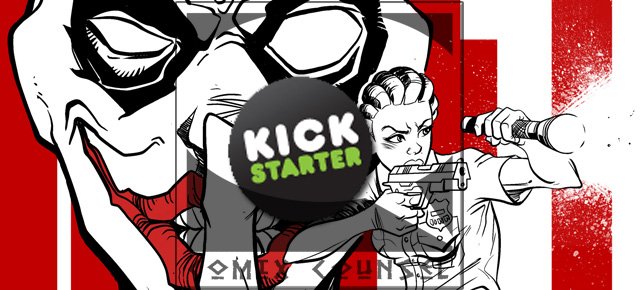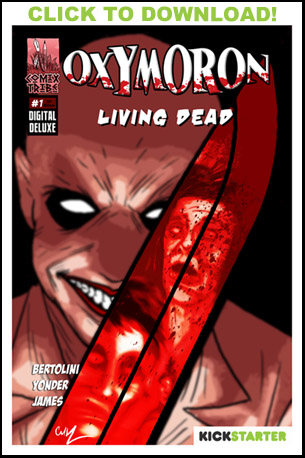My Approach to a Kickstarter Campaign
I launched a Kickstarter campaign today to raise pre-order funds for the OXYMORON Volume 1 hardcover collection, a graphic novel anthology project I’ve orchestrated. In today’s article, is all about my approach to a Kickstarter campaign design and execution. (Be sure to take my advice with a grain of salt, because who knows if this will be successful or not. Check back in a month!)
>>>Update! I suppose you could call raising 306% of my Kickstarter successful. Turns out this approach was a solid one. So, read on with a little more confidence that I know a little something about this crowdfunding thing…<<<
Why Kickstarter?
 This year, ComixTribe is experimenting with many different approaches to getting our books out to the public. We’re attending conventions, selling online in the ComixTribe shop, selling digitally, selling directly to shops in micro-distribution deals, and most recently, are working with the big dog Diamond to distribute SCAM world-wide. Clearly Kickstarter is not our only option to get Oxymoron out there. So, why KS?
This year, ComixTribe is experimenting with many different approaches to getting our books out to the public. We’re attending conventions, selling online in the ComixTribe shop, selling digitally, selling directly to shops in micro-distribution deals, and most recently, are working with the big dog Diamond to distribute SCAM world-wide. Clearly Kickstarter is not our only option to get Oxymoron out there. So, why KS?
To answer that, I need to go back to my original goals for this book:
- To create a great product with a compelling character that will extend THE RED TEN franchise.
- To work with a bunch of hardworking creators I respect the hell out of on a talent showcase book we can all be proud of.
- To sell as many copies, and get as many eyeballs on the work as humanly possible.
I, like many of you, have mixed feelings about the Kickstarter phenomenon. But I certainly pay a lot of attention to what seems to be working (and what doesn’t) in this industry. And for a number of reasons, which I’ll spell out below, I decided a few months ago that the Oxy anthology is a product that could potentially thrive on the Kickstarter platform.
What I’m seeing most recently with projects like Sullivan’s Sluggers, Smut Peddler Anthology, and the completed Antler Boy anthology, is that Kickstarter has grown to the point where it’s not only a crowd-funding mechanism, but it’s probably the single best product-selling platform available to independent creators with small to mid-sized audiences right now.
I liken Kickstarter to an online, one-table convention, where for a limited time you’re offering a product, and with the opportunity for upselling complementary products, directly to an engaged and interested consumer base. The more I ran the scenarios and considered other distribution/selling alternatives, the more I came to the conclusion that NOT using Kickstarter for this project would be leaving sales and attention on the table.
The other benefit of doing a Kickstarter is that it will allow me to pursue a stretch goal, something that wouldn’t be feasible without KS funding. Instead of collecting this short into a relatively cost-effective trade, I’ve set the goal for creating a premium hardcover product. While I’m sure the traditional system of first releasing issues as individual floppies, then collecting as a trade paperback, and then premium hardcover, can still make sense for some projects, I’m seeing too many examples of creators taking the bull by the horns and going for that premium book first not to be inspired to try.
There are also some other facts at play:
- Anthologies are traditionally a tough sell in comic shops for retailers. Anthologies are products that better lend themselves to hand selling at cons…or, as many recent examples have demonstrated, on Kickstarter.
- Likewise, indie graphic novels themselves are a tougher sell (in large quantities, anyway) to retailers. Most retailers are willing to take a flyer on a floppy. At most, they stand to lose a buck or two if they don’t sell. But a $15-$25 trade is another story altogether.
- Distributing though Diamond is still very much a goal and option for the OXYMORON hardcover. But as we’re finding out, there are no guarantees that orders will be high enough for Diamond to carry it. I’d argue that OXYMORON would likely become EASIER, not harder to sell through Diamond, AFTER a successful Kickstarter campaign. The benefit of world-wide distribution should be reaching the audience we DON’T already have. By proving that their IS an audience for this book with a successful Kickstarter, that gives us a better shot.
- Over the past several years, I and ComixTribe have built up a decent sized platform and audience. I’ve been “holding my powder” on pulling the Kickstarter trigger, because I don’t think it’s a well you can keep going to over and over again, and wanted to wait for something special. But in thinking about it, this project is totally in-line with the ComixTribe mission: Creators helping creators make better comics. With the help of the wider ComixTribe, we can make this collection BETTER.
- And finally, I’m betting that this book has a chance to do really well on KS. There is plenty of latent interest in this series, and OXY has a compelling, visceral appeal that gets proven at every convention I’ve done this year. Collectively, the talent involved has a good-sized platform, the stories are strong, and the art is stellar.
So, that’s a long-winded way of explaining why Kickstarter. I guess the biggest takeaway here is that you should really think about this question before you launch a campaign.
Take Your Time
Kickstarter makes it EASY to launch a campaign. In fact, you could probably log-on today and launch tomorrow, as their review time is often 24 hours or less.
Of course, I wouldn’t recommend that. Fun Fact: I NEVER once pulled an all-nighter in college. (Well, never one where I was working…) I am a tortoise, “a slow and steady wins the race” kind of dude. I started working on this Kickstarter campaign six weeks ago. I knew there was going to be a ton to do: writing copy, filming and editing videos, planning, budgeting, rallying troops, etc.
You only get to start the campaign once, so you might as well come out of the gate as hot as possible, right? To do it well takes time. So my tip here would be to give yourself plenty of time…more time than you think you need, to plan your campaign.
Do the Math
Making mistakes is a good thing. Hell, 90% of the content for my Comix Counsel articles is directly related to mistakes I’ve made in the past and lessons I’ve learned from them.
That said, I try not to make too many mistakes with a lot of zeroes in them. And Kickstarter offers plenty of opportunity to over-promise and under-budget: Forgetting about Kickstarter or Amazon fees, getting the cost of shipping off by a couple of dollars per unit, finding out printing will cost you 15% more than planned, etc. Multiply that by 200-300 pledges, and you may find yourself in the hole instead of ahead. There IS a such thing as a “worst-case success” with Kickstarter.
So, before getting too wrapped up in the fun part of the campaign, which is coming up with irresistible pledge level incentives, I did some research on costs:
– I got printing quotes from multiple printers for runs of 500/1000/1500/2000/2500 books.
– I took a similarly sized hardcover down to the post office and had it priced for shipping.
– I researched the cost of other merch: t-shirts, buttons, prints, etc.
And then I created a Kickstarter Pledge Planning Spreadsheet and used it to map out all the various pledge levels. [My actual spreadsheet has more information on it, but feel free to use this template as a starting point for planning your own Kickstarter.]
Point being, this is business. Do the math BEFORE the pledges start rolling in.
Setting the Goal
While “the math” can help you make sure your costs are in alignment with your pledge levels, setting the project target goal is a big decision. After all, raise even one dollar less than that goal and you’ll get NOTHING. So, you don’t want to set a goal to high. On the other hand, one needs to be realistic about the costs of your project. THE WORST THING you can do is set a goal, hit it, and then realize you can’t deliver what you promised at that funding level.
I ended up going with $8,500 as a project goal.
Honestly, I would have liked it to be less. Originally I wanted the goal to be between $5-6K. I wanted it large enough so that the project gets some attention, but small enough so that we hit the goal EARLY in the campaign. Because once you hit your goal, the dynamic of the campaign changes…it’s less about getting backers and more about attracting shoppers confident the book will happen. Sullivan’s Sluggers got to that point on Day 1, and it worked out tremendously for its creators.
That said, checking “the math” wouldn’t let me go that low. Just to get the presses running on a hardcover of this size will run over $5K. Shipping on this project will be substantial. If I wasn’t getting married this year, I’d be more flexible at setting a lower goal and covering the difference myself. (But apparently weddings are expensive…especially when bride and groom come from big Catholic families.)
By hitting a goal of $8,500, I’m leaving enough room for KS and Amazon fees, taxes, the cost of the print run, and shipping. It will still be tight, but won’t have me dipping into other funds and serving SPAM to my wedding guests this December.
Using the Platform
The Kickstarter platform is robust and optimized for a clean and appealing user experience. In planning, I looked at a TON of great examples of Kickstarter campaigns. The ones that appealed most to me:
- Had compelling videos.
- Had clear, concise information about the project and the funding goals.
- Had a nice balance of text and imagery.
- Had attractive, reasonably priced pledge levels.
- Had pledge level incentives that were supported by attractive images.
Making the Video
Including a video was a must have for my project. Kickstarter fact: Projects with videos succeed at a higher rate than those without (50% vs. 30%).
Though I once took a Summer production workshop at USC’s School of Cinema and Television, I’m no Spielberg. I DO like making and editing videos, however. Putting together my project video was a fun, though time-consuming endeavor.
The final edit of my video came in a lot shorter than I planned. In my research, I found that most successful campaigns’ videos are averaging only about 2 minutes in length…around the length of most “viral” Youtube videos. Truth is, only moms and stalkers are going to sit through a 20 minute video of you or I blabbing about our projects. So I cut!
Tools I Used:
- Windows Live Movie Maker – To edit and produce the finished cut, and to add titles and music. [Free]
- MuVee Autoproducer 6.1 – For the book preview montages. [~$39.00]
- Audacity – Audio mixing and Conversions. [Free]
- SoundCloud – For Creative Commons background music. [Free]
Supporting Video
The reason my video was tracking so long was because I wanted to give the great stories in Oxymoron Volume I a chance to shine. But even just a quick mention of creative team and an elevator pitch for each story would take close to five minutes, and that was just too long for a project video. But then I realized…HEY! Just make ANOTHER VIDEO!
Here’s one of the under-utilized features of the Kickstarter page…the supplemental video. Instead of squeezing everything into the main video, I created a separate video highlighting all the stories and embedded it a bit down the page. Folks that want to see more of a preview can here.
Give More Than a Taste
One of the advantages my project has over others is that the work is 95% done. I really think with any campaign, you need to recognize and exploit your advantages for all they are worth.
Because most of the book is complete, and there are plenty of stories in it, I decided it was worthwhile to give one of the stories out FREE to everyone. The hardest decision of course was choosing which story to give out as a free sample.
I ended up going with Mark Bertolini and Carl Yonder‘s story “Living Dead” as my sample give away for a number of reasons:
- It was one of the first fully complete stories, and thus ready to go.
- It has the easiest “high concept” and broadest “commercial” appeal…Oxy vs. Zombies, which are apparently hot right now. (Thank you, Mr. Kirkman!)
- Tonally, it is a good representative of the rest of the content, with the appropriate blend of humor, violence, and Oxy-isms.
It’s a quick, fun read, that will ideally have readers coming back for more. And of course, I loaded the back of the PDF with teases for the rest of the stories and info to push folks back to the Kickstarter to grab the hardcover. So spread, tweet, and torrent away, internet!
Preparing My Base
Launching a campaign is tricky business. On the one hand, you want to hold your cards close to the vest to make as big a splash upon release as possible. On the other, the last thing you want is to throw a party and have no one show up because they didn’t know about it.
Kickstarter is not about selling to strangers…at least not at first. It’s about rallying your base. ComixTribe first announced this book back in April. I then started teasing previews of the Oxymoron graphic novel on the OXY production blog months ago, regularly tweeting it up as well.
Last week, in this space, I announced that I’d be launching a Kickstarter, and this week I first let ComixTribe and THE RED TEN readers know about the campaign, and then announced publicly on ComixTribe.
Big events have build up…A campaign is a big event. I’ve worked to get the word out to my base, and I’m confident they’ll show up. The only question is whether my base is big enough to reach this particular goal.
Keeping Momentum
I think I have a GREAT set of incentives on the Kickstarter page right now. But I have WAY more waiting in the wings. The monumental success of the Order of the Stick Kickstarter drive really blazed the trail, showing that that celebrating milestones…whether pre-or post- hitting your target, is an effective way at keeping momentum for a project going the whole month-long.
So, as you can see on my Kickstarter, at 10% funding, new reward levels will be unlocked. And at certain funding levels, the projects and rewards backers have already earned will get better.
And there you have it. This is my general approach…it’s a synthesis of what I’ve seen other’s do successfully with my own spin on it. Again, I’ll write a companion piece a month from now on what I’ve learned going through this process…assuming my sanity is in tact.
Wish me luck!
If you’ve found this article informative, please share it:
Discuss this Article in the ComixTribe Forums
Keep Reading!
If you found this article useful, you may want to read one of these three articles next:
5 Things I Learned Running a Successful Kickstarter
Kickstarter: 10 Things I Think I Know
DIY Crowdfunding Fulfillment Part I – What To Do BEFORE You Launch?
Related Posts:
Category: Comix Counsel



















Comments (4)
Trackback URL | Comments RSS Feed
Sites That Link to this Post